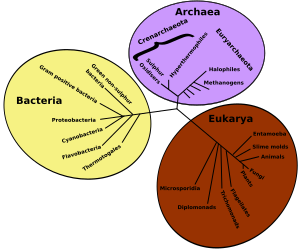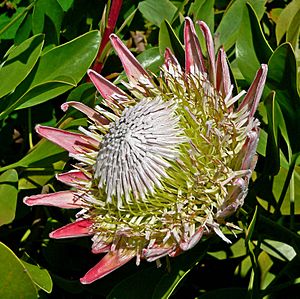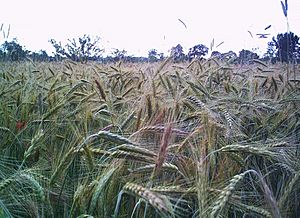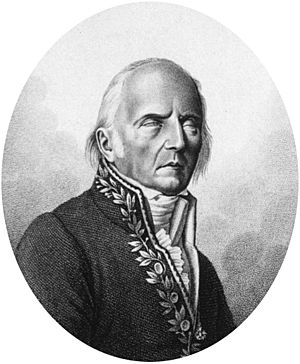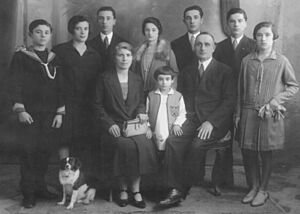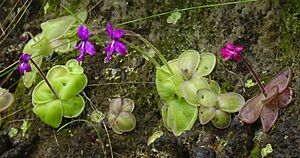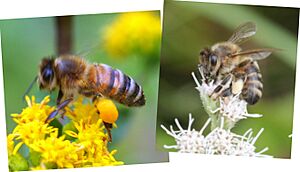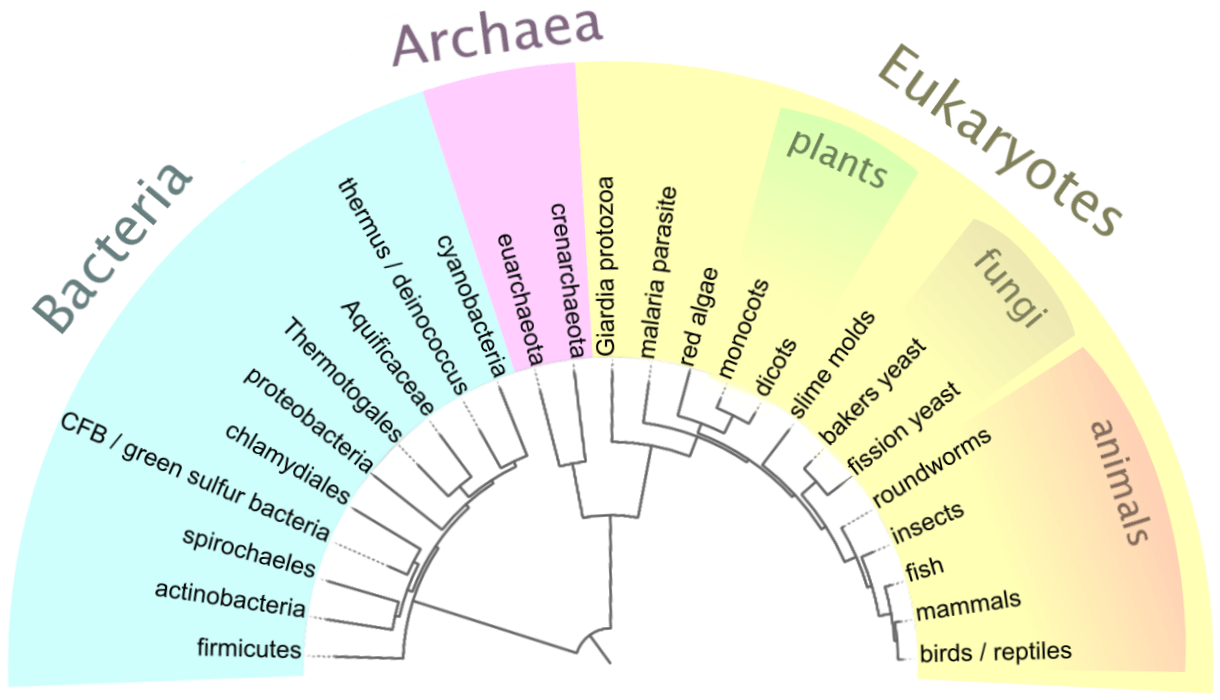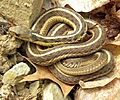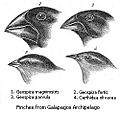Evolution facts for kids
Evolution is a big idea in biology. It helps us understand how all living things on Earth have changed over a very long time. It also explains how they became the way they are today.
Our planet is incredibly old. By looking at the different layers of rock, scientists can learn about Earth's past. This study is called historical geology.
We know that living things have changed because we find their fossils in rocks. Fossils are the remains of ancient plants and animals. These fossils show us that today's animals and plants are very different from those that lived long ago. The further back we look, the more different the fossils become. This change is what we call evolution. That evolution has happened is a fact, because lots of evidence supports it. Scientists are still actively researching many questions about evolution.
By comparing the DNA of different organisms, scientists can group them by how similar their DNA is. This helps show how living things are related. In 2010, a study of DNA sequences strongly supported the idea that all life shares a common ancestor. This means all life on Earth is connected.
The theory of evolution is the foundation of modern biology. As one famous biologist said, "Nothing in biology makes sense except in the light of evolution."
Contents
Evidence for Evolution
There is a lot of evidence that shows evolution has happened. Let's look at some of it.
Fossils Show How Life Has Changed
Realizing that rocks held fossils was a huge step in natural history. Here's how we learned about them:
- People realized that strange shapes in rocks were actually the remains of ancient living things. This was figured out in the 1500s and 1600s by scientists like Conrad Gessner and Robert Hooke.
- Scientists like Georges Cuvier discovered that many fossils belonged to species that no longer exist today. This proved that extinction happens. They also saw that different rock layers held different fossils.
- People noticed that older fossils were simpler living things than newer ones. Also, the newer the rocks, the more the fossils looked like today's animals and plants.
As Ernst Mayr said, "The most convincing evidence for the occurrence of evolution is the discovery of extinct organisms in older geological strata... The older the strata are...the more different the fossil will be from living representatives... that is to be expected if the fauna and flora of the earlier strata had gradually evolved into their descendants."
How Horses Evolved

The evolution of the horse family is a great example of how evolution works. The oldest horse fossil is about 52 million years old. This ancient horse was small, about the size of a fox. It had five toes on its front feet and four on its back feet. It lived in woodlands, eating leaves, nuts, and fruit with its simple teeth.
About 30 million years ago, the world became cooler and drier. Forests shrank, and grasslands grew. Horses changed to fit this new environment. They started eating grass, grew larger, and ran faster to escape predators. Horses with teeth that lasted longer had an advantage because grass wears teeth down.
For a long time, there were many different types of horses. But today, only one group exists: the modern horse, Equus. It has teeth that grow throughout its life, hooves on single toes, and long legs for running. It is big and strong enough to live on open plains. Horses lived in western Canada until about 12,000 years ago. All horses in North America then died out around 11,000 years ago. Scientists are still studying why this happened. Ideas include Climate change and too much hunting by humans.
So, scientists can see that changes have happened slowly over a very long time. The theory of evolution explains how these changes came about.
Geographical Distribution
The way species are spread across the world greatly interested Charles Darwin and Alfred Russel Wallace. When new species appear, usually by splitting from older ones, they start in one place. From there, they might spread to some areas but not others.
Australasia's Unique Animals
Australasia (Australia and nearby islands) has been separated from other continents for millions of years. In Australia, most mammals (83%), reptiles (89%), fish and insects (90%), and amphibians (93%) are found nowhere else. Its native mammals are mostly marsupials, like kangaroos and bandicoots. In contrast, marsupials are almost gone from Africa and are a small part of the animals in South America.
The only living egg-laying mammals (monotremes) are echidnas and the platypus. They are only found in Australasia. Australia does not have many groups of placental mammals common elsewhere, like carnivores or shrews. However, it does have native bats and rodents, which arrived later.
The evolutionary story is that placental mammals evolved in Eurasia. They spread and replaced marsupials and monotremes wherever they went. But they did not reach Australasia until more recently. This is why Australia has most of the world's marsupials and all its monotremes.
Hawaiian Drosophila Flies
The Hawaiian Islands have the most diverse collection of Drosophila flies in the world. They live in many different places, from rainforests to mountain meadows. About 800 types of Hawaiian drosophilid flies are known.
Genetic evidence shows that all native Hawaiian drosophilid species came from a single ancestor. This ancestor arrived on the islands about 20 million years ago. The new species formed quickly because there was little competition and many empty niches (roles in the environment).
Glossopteris Plant Distribution
The combination of continental drift and evolution helps explain what we find in the fossil record. Glossopteris is an extinct plant from the Permian period. It grew on the ancient supercontinent of Gondwana.
Glossopteris fossils are found in Permian rocks in parts of South America, Africa, Madagascar, India, Australia, New Zealand, and Antarctica. During the Permian period, all these continents were connected as Gondwana. We know this from magnetic patterns in rocks, other fossil findings, and marks left by glaciers.
Common Descent
When biologists look at living things, they see that animals and plants belong to groups that share common features. Charles Darwin explained that this happens naturally if we accept that related forms share a common ancestor and then change over time.
For example, all insects are related. They share a basic body plan: six legs, a hard outer shell (exoskeleton), and eyes made of many small parts. Biologists explain this with evolution. All insects are the descendants of an ancient group of animals. They kept the basic plan but changed in different ways over time. This is evolution.
Darwin was the first to suggest that all life on Earth came from a single origin. From that beginning, "endless forms most beautiful and most wonderful have been, and are being, evolved." Recent evidence from molecular biology strongly supports the idea that all life is related through common descent.
Vestigial Structures
Vestigial structures provide strong evidence for common descent. These are body parts that are smaller and simpler than similar parts in ancestral species. They were once useful but are now either useless or have a new function. For example, flightless beetles have useless wings sealed under their wing covers. This is easily explained if they came from ancestors that had working wings.
Other examples include the pelvic girdles (hip bones) of whales, the small hind wings (halteres) of flies, and the wings of flightless birds. The leaves of some xerophytes (like cactus) and parasitic plants (like dodder) are also vestigial.
Sometimes, vestigial structures get a new job. The halteres in flies now help them balance during flight. Ostrich wings are used in mating rituals and aggressive displays. The ear ossicles in mammals were once bones in the lower jaw.
Darwin wrote that "Rudimentary organs plainly declare their origin and meaning..." and "are the record of a former state of things, and have been retained solely though the powers of inheritance..."
In 1893, Robert Wiedersheim listed 86 human organs he thought were vestigial. This list included the appendix and wisdom teeth.
A baby's strong grip is another example. It's a leftover reflex from when early human babies clung to their mothers' hair as they swung through trees. This is supported by how babies' feet curl up when sitting, as primate babies also grip with their feet. This reflex allowed mothers to escape danger by climbing trees with both hands and feet.
Vestigial organs often shrink because keeping them big uses up energy. If they no longer have a function, making them smaller saves resources and helps the animal survive better.
Embryology
Since the 1700s, scientists have known that the embryos of different species look much more similar than the adults. Some parts of embryos show their evolutionary past. For example, land vertebrate embryos develop gill slits, just like fish embryos. These are only temporary and later form other structures in the neck of reptiles, birds, and mammals. These proto-gill slits stayed because they are part of a complex development system.
Another example is the embryonic teeth of baleen whales. These teeth are later lost. The baleen filter (used for feeding) develops from different tissue called keratin. Early fossil baleen whales actually had both teeth and baleen.
A good example is the barnacle. It took many years for natural historians to realize that barnacles were crustacea. Adult barnacles look very different from other crustacea, but their larvae (young forms) are very similar.
Artificial Selection


Charles Darwin lived in a time when animal husbandry (raising animals) and domesticated crops were very important. Farmers would choose animals or plants with special traits to breed. They would prevent those with less desirable traits from breeding. This practice was part of the growth of scientific agriculture in the 1700s and 1800s.
Darwin talked about artificial selection as a way to understand natural selection in his 1859 book, On the Origin of Species. He wrote, "Slow though the process of selection may be, if feeble man can do much by his powers of artificial selection, I can see no limit to the amount of change... which may be effected in the long course of time by nature's power of selection."
Nikolai Vavilov showed that rye, which was originally a weed, became a crop plant by accident. Rye is tougher than wheat and can grow in harsher conditions. Because it grew alongside wheat, rye eventually became a crop plant in tough areas like hills and mountains.
There isn't a real difference in the genetic processes behind artificial and natural selection. Darwin used artificial selection to help explain the broader process of natural selection. However, artificial selection can make changes happen much faster. Experiments show that evolution rates in artificial selection are at least 100 times faster than what we see in nature or in the fossil record.
Creating New Species Artificially
Some people used to think that artificial selection could not create new species. But now it seems it can.
New species have been created through animal breeding, though the details are not always clear. For example, domestic sheep were created by mixing different types. They can no longer have fertile babies with Ovis orientalis, one of their wild ancestors. On the other hand, domestic cattle can still have fertile offspring with several wild types of ox, like gaur and yak.
The best examples of new species created in a lab came from experiments in the late 1980s. William Rice and G.W. Salt bred fruit flies, Drosophila melanogaster. They used a maze with different choices of habitat, like light/dark or wet/dry. Each generation of flies went through the maze. The groups of flies that came out of two specific exits were kept separate to breed.
After 35 generations, the two groups of flies could no longer reproduce with each other. This was because they had strong preferences for their own habitats. They only mated with flies that preferred the same areas.
Diane Dodd also showed how reproductive isolation can happen in Drosophila pseudoobscura fruit flies. After only eight generations, using different food types (starch and maltose), the flies developed mating preferences.
 Dodd's experiment has been easy for other scientists to repeat. It has also been done with other fruit flies and different foods.
Dodd's experiment has been easy for other scientists to repeat. It has also been done with other fruit flies and different foods.
Observable Changes
Some biologists say evolution happens when a trait caused by genetics becomes more or less common in a group of organisms. Others call it evolution when new species appear.
Changes can happen quickly in smaller, simpler organisms. For example, many bacteria that cause disease can no longer be killed by some antibiotic medicines. These medicines have only been used for about 80 years. At first, they worked very well. But the bacteria have evolved to resist the antibiotics. The drugs killed most bacteria, but a few that had some resistance survived. These resistant bacteria then produced the next generation.
The Colorado beetle is known for its ability to resist pesticides. Over the last 50 years, it has become resistant to 52 different chemical compounds used in insecticides, including cyanide. This is natural selection happening very quickly due to human-made conditions. However, not every group of beetles is resistant to every chemical. They only become resistant to the chemicals used in their local area.
History of Evolutionary Ideas
While some natural historians in the 1700s had ideas about evolution, the first clear theories came in the 1800s. Three biologists were especially important.
Lamarck's Ideas
Jean-Baptiste de Lamarck (1744–1829), a French biologist, believed animals changed based on natural laws. He thought animals could pass on traits they gained during their lifetime to their children. This idea is called Lamarckism. He suggested that organisms tend to become more complex. He also believed in "use and disuse" – if an animal used a part a lot, it would grow stronger and be passed on.
Lamarck's idea was that a giraffe's neck grew longer because it stretched to reach higher leaves. This idea was later shown to be wrong. It doesn't fit with how heredity works, which was discovered by Gregor Mendel about 50 years after Lamarck.
Darwin's Theory
Charles Darwin (1809–1882) published his book On the Origin of Species in 1859. In it, he presented a lot of evidence that evolution had happened. He also suggested natural selection as the main way evolution took place. However, Darwin did not understand genetics or exactly how traits were passed on. He couldn't fully explain why children looked like their parents.
Despite this, Darwin's explanation of evolution was mostly correct. Unlike Lamarck, Darwin's idea was that the giraffe's neck became longer because giraffes with slightly longer necks survived better. These survivors passed their genes on. Over time, the whole group of giraffes developed longer necks.
Mendel's Discoveries
An Austrian monk named Gregor Mendel (1822–1884) studied plants. In the mid-1800s, he found out how traits are passed from one generation to the next.
He used peas for his experiments. Some peas had white flowers, others red. Some had green seeds, others yellow. Mendel used pollination to breed the peas. His findings are explained in Mendelian inheritance. Darwin thought that traits from both parents blended together. Mendel proved that the genes from two parents stay separate. They can be passed on unchanged to later generations.
Mendel published his results in a journal that wasn't well-known, so his discoveries were overlooked. Around 1900, his work was rediscovered. Genes are pieces of information made of DNA. They act like a set of instructions. Every living cell has a set of genes. Genes guide how an egg develops into an adult. In mammals and many other living things, one copy of each gene comes from the father and another from the mother. Some organisms, like certain plants, have only one parent and get all their genes from them. These genes create the genetic differences that evolution works on.
Darwin's Theory Explained
Darwin's On the Origin of Species had two main parts: the evidence for evolution, and his ideas on how evolution happened. This section focuses on his ideas about how it works.
Variation in Living Things
The first chapters of Origin talk about variation in farm animals and plants, and in nature.
All living things show variation. Every group of animals or plants studied shows that individuals are different, just like humans are. This is a huge fact of nature. Without it, evolution could not happen. Darwin said that just as humans choose what they want in their farm animals, nature also "selects" based on these variations.
An individual's features are shaped by two things: heredity (what they inherit) and their environment. First, development is controlled by genes inherited from parents. Second, life experiences also have an effect. Some traits are fully inherited, some partly, and some not at all.
Eye color is fully inherited. Height or weight are only partly inherited. The language a person speaks is not inherited at all. (The ability to speak is inherited, but the specific language depends on where a person lives and what they are taught.)
Evolution only affects traits that can be inherited, either fully or partly. Inherited traits are passed from one generation to the next through genes. A person's genes contain all the traits they inherit from their parents. Life accidents are not passed on. Also, everyone lives a slightly different life, which increases differences.
Organisms in any group vary in how many offspring they have that survive and reproduce. In evolution, "reproductive success" means the total number of offspring that live to breed and have their own offspring.
Inherited Variation
Variation can only affect future generations if it is inherited. Thanks to Gregor Mendel's work, we know that much variation is inherited. Mendel's "factors" are now called genes. Research shows that almost every individual in a sexually reproducing species is genetically unique.
Genetic variation increases through gene mutations. DNA doesn't always copy perfectly. Rare changes happen, and these changes can be inherited. Many DNA changes cause problems. Some are neutral, meaning they have no effect. Some are even helpful. These changes create genetic variation, which is the raw material for evolution. Sexual reproduction, through the mixing of chromosomes during meiosis, spreads variation through a group. Other things, like natural selection and drift, reduce variation. So, a wild population always has variation, but the details are always changing.
Natural Selection
Evolution mainly works through natural selection. What does this mean? Animals and plants that are best suited to their environment will, on average, survive better. There is a struggle for existence. Those who survive will produce the next generation. Their genes will be passed on, while the genes of those who did not reproduce will not. This is the basic way a population changes and evolves.
Natural selection explains why living organisms change over time to have the body parts, functions, and behaviors they do. It works like this:
- All living things can have so many offspring that their population could grow very fast forever.
- But we see that populations don't grow that much. Their numbers usually stay about the same.
- Food and other resources are limited. So, there is competition for food and resources.
- No two individuals are exactly alike. So, they won't have the same chances to live and reproduce.
- Much of these differences can be inherited. Parents pass these traits to their children through their genes.
- The next generation can only come from those that survive and reproduce. After many generations, the population will have more helpful genetic differences and fewer harmful ones. Natural selection is really a process of elimination. The environment eliminates individuals that don't fit well.
Selection in Nature
There are now many cases where natural selection has been proven to happen in wild populations. Almost every study of camouflage, mimicry, and polymorphism (different forms within a species) has shown strong effects of selection.
The power of selection can be much stronger than early scientists thought. Resistance to pesticides has grown quickly. Resistance to warfarin in Norway rats grew fast because the rats that survived made up more and more of the population. Research showed that without warfarin, resistant rats were at a big disadvantage. But the selection for warfarin resistance quickly overcame this disadvantage.
Most mammals cannot drink milk as adults, but humans are an exception. Milk is digested by an enzyme called lactase. This enzyme usually switches off as mammals stop drinking milk from their mothers. The human ability to drink milk as adults is due to a lactase gene change that prevents this switch-off. Human populations have a high number of people with this change wherever milk is an important part of their diet. The spread of this "milk tolerance" is helped by natural selection. It helps people survive where milk is available. Genetic studies suggest that the oldest changes causing lactase persistence only became common in human populations in the last ten thousand years. So, lactase persistence is often seen as an example of recent human evolution. Since lactase persistence is genetic, but raising animals for milk is a cultural trait, this is an example of gene–culture coevolution.
Adaptation
Adaptation is one of the basic things we see in biology. Through adaptation, an organism becomes better suited to its habitat.
Adaptation is one of the two main processes that explain the many different species we see. The other is speciation (when one species splits into two). A good example used today to study adaptation and speciation is the evolution of cichlid fish in African rivers and lakes.
When people talk about adaptation, they often mean something that helps an animal or plant survive. One of the most common adaptations in animals is the evolution of the eye. Another example is how horses' teeth adapted to grinding grass. Camouflage is another adaptation, and so is mimicry. The better adapted animals are more likely to survive and reproduce successfully (natural selection).
An internal parasite (like a fluke) is a good example. It has a very simple body structure, but it is highly adapted to its specific environment. This shows that adaptation isn't just about visible traits. In such parasites, important adaptations happen in their life cycle, which is often quite complex.
Limitations of Adaptations
Not all features of an organism are adaptations. Adaptations often show how a species lived in the past. If a species has recently changed its way of life, an adaptation that was once useful might become useless. It could eventually become a shrinking vestige.
Adaptations are never perfect. There are always trade-offs between different functions and structures in a body. It's the whole organism that lives and reproduces. So, the complete set of adaptations is what gets passed on to future generations.
Genetic Drift and Its Effect
In populations, some forces add variation (like mutation), and some remove it. Genetic drift refers to random changes that remove variation from a population. Genetic drift reduces variation. It is "a very weak evolutionary force in large populations."
Genetic drift explains how random chance can affect evolution in surprisingly big ways, but only when populations are quite small. Overall, it makes individuals more similar to each other. This can make them more vulnerable to disease or random events in their environment.
- Drift reduces genetic variation in populations. This can make a population less able to survive new challenges.
- Genetic drift acts faster and has bigger effects in smaller populations. Small populations often die out.
- Genetic drift might help create new species if the small group survives.
- Bottleneck events: These happen when a large population suddenly shrinks a lot due to an event. The genetic variety will be greatly reduced. Infections and extreme climate events are common causes. Sometimes, invasions by more competitive species can be devastating.
* In the 1880s and 1890s, hunting reduced the Northern elephant seal to only about 20 individuals. Even though the population has grown back, its genetic variety is much less than that of the Southern elephant seal. * Cheetahs have very little genetic variation. Scientists think the species was reduced to a small number at some point. Because it lacks genetic variation, it is in danger from infectious diseases.
- Founder events: These happen when a small group breaks off from a larger population. This small group then lives separately. The human species is often said to have gone through such stages. For example, when groups left Africa to settle elsewhere (see human evolution). Apparently, humans have less genetic variation than would be expected from our worldwide spread.
* Groups that arrive on islands far from the mainland are also good examples. These small groups cannot carry all the different alleles (gene versions) found in the original population.
How New Species Form
How species form is a major part of evolutionary biology. Darwin first thought of "evolution" (a word he didn't use at first) as being about how new species appear. That's why he called his famous book On the Origin of Species.
Darwin thought most species came directly from existing species by changing over time. This is called anagenesis. Now, we think most species form when a previous species splits into two. This is called cladogenesis.
Species Splitting
Two groups that start out the same can become very different if they live in different places. When a species is split into two separate geographical regions, a process begins. Each group adapts to its own situation. After a while, individuals from one group can no longer reproduce with the other group. Two new species have evolved from one.
A German explorer, Moritz Wagner, studied flightless beetles in Algeria in the 1830s. Each species was found only along a stretch of the north coast between rivers flowing from the Atlas mountains to the Mediterranean. As soon as one crossed a river, a different but closely related species appeared. He later wrote that a new species would only appear when a few individuals crossed their usual borders. He believed a new group would never form without a long separation from the main species. This was an early idea about how important geographical separation is. Another biologist who thought geographical separation was key was Ernst Mayr.
One example of natural speciation is the three-spined stickleback. This sea fish, after the last ice age, moved into freshwater. It set up colonies in isolated lakes and streams. Over about 10,000 generations, these sticklebacks show big differences. These include variations in fins, changes in the number or size of their bony plates, different jaw structures, and color differences.
The wombats of Australia are divided into two main groups: Common wombats and Hairy-nosed wombats. They look very similar, except for the hairiness of their noses. However, they are adapted to different environments. Common wombats live in forests and eat mostly green, moist food. They often feed during the day. Hairy-nosed wombats live on hot, dry plains. They eat dry grass with little water or nutrients. Their body system is slow, and they sleep most of the day underground.
When two groups that started the same become different enough, they become two different species. Part of the theory of evolution is that all living things started off the same. Then, they split into different groups over billions of years.
Modern Evolutionary Synthesis
This was an important movement in evolutionary biology. It started in the 1930s and was largely completed by the 1950s. It has been updated regularly since then.
The synthesis explains how Charles Darwin's ideas fit with Gregor Mendel's discoveries about how we inherit our genes. The modern synthesis brought Darwin's ideas up to date. It connected the work of different types of biologists: geneticists, naturalists, and palaeontologists.
When the theory of evolution was first developed, it wasn't clear how natural selection and genetics worked together. But Ronald Fisher showed that natural selection would indeed change species. Sewall Wright explained genetic drift in 1931.
Here are some key ideas from the modern synthesis:
- Evolution and genetics: Evolution can be explained by what we know about genetics and what we see in wild animals and plants.
- Populations, not individuals: Thinking about populations rather than just individuals is important. The genetic variety in natural populations is key to evolution.
- Evolution and fossils: The same factors that act today also acted in the past.
- Gradualism: Evolution usually happens slowly, in small steps. There are some exceptions, like polyploidy (having more than two sets of chromosomes), especially in plants.
- Natural selection: The struggle for existence among animals and plants in the wild causes natural selection. The power of natural selection in the wild was greater than even Darwin expected.
- Genetic drift: This can be important in small populations.
- Rate of evolution: The speed of evolution can vary. Fossils show very good evidence that different groups can evolve at different rates. Also, different parts of an animal can evolve at different rates.
Some Areas of Research
Co-evolution
Co-evolution is when the existence of one species is closely linked to the life of one or more other species.
New or "improved" adaptations in one species are often followed by related features appearing and spreading in the other species. The lives of living things are deeply connected, not just with their physical environment, but with the lives of other species.
These relationships can last for millions of years. A great example is the pollination of flowering plants by insects. The gut contents, wing structures, and mouthparts of fossilized beetles and flies suggest they were early pollinators. The connection between beetles and angiosperms (flowering plants) during the Lower Cretaceous period led to both groups evolving rapidly at the same time. The evolution of nectaries (parts of flowers that produce nectar) in Upper Cretaceous flowers shows the start of the partnership between hymenoptera (like bees) and angiosperms.
Tree of Life
Charles Darwin was the first to use the idea of a "tree of life" in biology. The evolutionary tree shows how different biological groups are related. It uses information from DNA, RNA, and protein analysis. The "tree of life" work combines traditional comparative anatomy (comparing body structures) with modern molecular evolution and molecular clock research.
A key figure in this work is Carl Woese. He defined the Archaea, which is the third main group (or domain) of life. Below is a simplified version of what scientists understand today.
Macroevolution
Macroevolution is the study of changes that happen above the species level. It looks at how these big changes take place. The main information for this study comes from fossils (palaeontology) and from rebuilding ancient environments. Some topics studied in macroevolution include:
- Adaptive radiation: When many new species quickly evolve from a single ancestor, like the Cambrian Explosion.
- Changes in biodiversity over time.
- Mass extinctions: When many species die out at once.
- Speciation and extinction rates: How fast new species form and old ones die out.
- Punctuated equilibrium vs. gradualism: The debate about whether evolution happens in sudden bursts or slowly over time.
- Role of development: How the way an organism develops affects its evolution, for example, with hox genes.
- Origin of major groups: Like the origin of the cleidoic egg (a type of egg that can be laid on land) or the origin of birds.
Macroevolution is a convenient term. For most biologists, it doesn't mean the process of evolution itself changes. However, some palaeontologists believe that what they see in the fossil record cannot be explained only by slow, gradual evolution. But they are a minority.
Altruism and Group Selection
Altruism is when an individual is willing to sacrifice itself for others. This is common in social animals. As explained earlier, the next generation comes only from those who survive and reproduce. Some biologists thought this meant altruism couldn't evolve through normal selection. Instead, they suggested "group selection." This idea means that certain genes might spread in a population because they benefit the group, even if they don't directly benefit the individual.
For several decades, scientists questioned group selection as a major way evolution happens.
In simple cases, it's clear that traditional selection is enough. For example, if one sibling sacrifices itself for three siblings, the genetic tendency for that act will increase. This is because siblings share about 50% of their genes. The sacrifice leads to more copies of those genes in the next generation.
Altruism is now generally seen as coming from standard selection. The ideas of Ernst Mayr and the work of William Hamilton are important to this discussion.
Hamilton's Equation
Hamilton's equation helps describe whether a gene for altruistic behavior will spread in a population. The gene will spread if rxb is greater than c:
Where:
 is the cost to the altruist (in terms of reproduction).
is the cost to the altruist (in terms of reproduction). is the benefit to the person receiving the altruistic behavior (in terms of reproduction).
is the benefit to the person receiving the altruistic behavior (in terms of reproduction). is the chance that the individuals share an altruistic gene – how closely related they are.
is the chance that the individuals share an altruistic gene – how closely related they are.
Amazing Discoveries from Fossils
- Land-living ancestors of whales
- How life moved from water to land (see tetrapod)
- The origin of feathers (see origin of birds)
- The evolutionary history of teeth
- The origin of the vertebrate skeleton
Amazing Discoveries from Habitats
- Natural selection in speciation
- Natural selection in lizards
- A case of co-adaptation
- How wild birds spread out differently
- Selective survival in wild guppies
- Why evolutionary history matters
Amazing Discoveries from Molecular Processes
- Darwin's Galapagos finches
- How Microevolution (small changes) meets macroevolution (big changes)
- Toxin resistance in snakes and clams
- Variation versus stability
- Nature is the oldest scientific weekly journal. The link downloads as a free text file, complete with references. The idea is to make the information available to teachers.
Related pages
Images for kids
-
In 1842, Charles Darwin wrote his first ideas for On the Origin of Species.
-
A baleen whale skeleton. Letters a and b show flipper bones, which came from front leg bones. Letter c shows vestigial leg bones. Both suggest adaptation from land to sea.
-
Common garter snake (Thamnophis sirtalis sirtalis) has evolved resistance to the defensive substance tetrodotoxin found in its amphibian prey.
-
Geographical isolation of finches on the Galápagos Islands led to over a dozen new species.
-
Tyrannosaurus rex. Non-avian dinosaurs died out in the Cretaceous–Paleogene extinction event at the end of the Cretaceous period.
-
The hominoids (apes) are descendants of a common ancestor.
-
As evolution became widely accepted in the 1870s, caricatures of Charles Darwin with an ape or monkey body became a symbol of evolution.
See also
 In Spanish: Evolución biológica para niños
In Spanish: Evolución biológica para niños


